Persian cuisine
Persian cuisine
Persian cuisine made and left a big influence in the other cuisines in the middle East with its special senses and freshness. We can be sure about it, if we say, that one of the pillars in persian food are fruits and vegetables. In a big country like Iran, there are all kinds of different fruits, that can be find in a diverse parts and regions. Important is to say, that the freshness give the special taste of food, which is surely making every meal so unique.
The most common foods that Iranians use in their diet are rice, cereals and meat, but most of all they eat veggies. If we talk about meat as an integral part, we also have to mention a big selection of fish, that can be found in the South in the Persian Gulf, as well as in the North, in the Caspian Sea. Healthy shrimps, different sorts of salmon, and of course, one of the best Caviar, straight from the Caspian, are well known all around the world. This kind of Caviar is obtained from a twin fish, which is not easy to find everywhere. Mutton is a main meat, but for sure not the only one, because you can try many dishes made of chicken or veal. Very often the combination of mutton and veal is used for a special taste of a dish.
Persian cuisine is reflected above all in the skill of combining spices of different tastes and odors. A traditional Iranian food menu includes Kebab, Fesenjan,Baghali Polo and Ash e Reshteh. The most famous Iranian food is QQQ and the most famous spice of Persian cuisine, and at the same time far known, is mint, which can be seen in food and drinks. Persians also use lemon essences in the preparation of their dishes and use edible flowers such as geranium, orange flower and rose petals.
Among the famous persian spices we can still count curcuma - a spice of orange color, and its taste is similar to ginger and saffron.
Although only a few hundred years ago in Iran, the consume of a coffee was number one but nowdays its role has been raplaced by persian tea. Having several tea breaks in a day is a special ritual in Iran.
Along together with sugar or nabat- Iranian crystal sugar, this kind of tea represents a true pleasure.
A tea poured from a ceramic teapot, or a samovar, mixed with hot water, makes a great color and tastes aromatic and wonderful.
Some of the most favorite and essential persian dishes are:
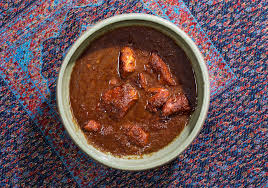 Fesenjan (Pomegranate Walnut Stew)
Fesenjan (Pomegranate Walnut Stew)
This iconic stew, an essential part of every Persian wedding menu, pairs tart pomegranate with chicken or duck. Ground walnuts, pomegranate paste and onions are slowly simmered to make a thick sauce. Sometimes saffron and cinnamon are added, and maybe a pinch of sugar to balance the acid. Fesenjan has a long pedigree. At the ruins of Persepolis, the ancient ritual capital of the Persian Empire, archaeologists found inscribed stone tablets from as far back as 515 B.C., which listed pantry staples of the early Iranians. They included walnuts, poultry and pomegranate preserves, the key ingredients in fesenjan.
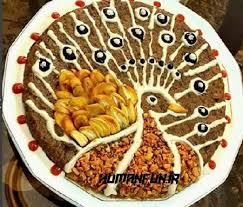 Bademjan (Eggplant And Tomato Stew)
Bademjan (Eggplant And Tomato Stew)
This stew has the shimmering red-gold color of tomatoes cooked with turmeric, with a sheen of oil on top, a prized characteristic in Persian cooking that shows a stew has been cooked long enough for the oils to rise up. Slightly tart, with the tang of tomatoes, lemon juice, and sometimes the juice of unripe grapes, its tanginess is kept in check by the eggplant, which is first fried on its own until golden-brown, then cooked with onions, lamb and the tomatoes and seasoning. Like all Persian stews, bademjan is thick and meant to be eaten over rice with a fork.
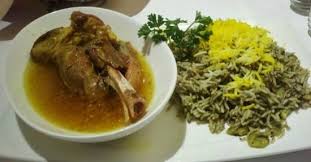 Baghali Polo (Rice With Dill And Fava Beans)
Baghali Polo (Rice With Dill And Fava Beans)
In Iranian cooking, rice can be prepared simply with butter and saffron, known as chelo. But just as often, it’s cooked with other ingredients and called polo. Polo can be made with herbs, vegetables, beans, nuts, dried fruit, meat and even noodles, and acts as the centerpiece of the meal. This polo is particularly good in the spring, when fava beans are young and tender and dill is in season. The dish is flecked with green dill and favas, and is often cooked with very tender chunks of lamb. Alternately, it may be served alongside lamb on the bone. The rice should have a mild saffron flavor, with the saffron mixed into the rice just before serving.
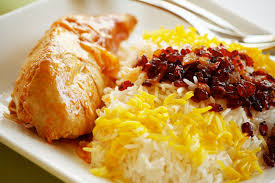 Zereshk Polo (Barberry Rice)
Zereshk Polo (Barberry Rice)
Iranians love sour flavors. Like cranberries, barberries have a vibrant red color, but they’re even more sour. This classic rice dish is studded with the red berries, which are dried and then re hydrated before cooking. The rice is cooked with plenty of butter, which helps to soften the intensity of the berries. Quince, rhubarb, green plums, sour oranges, lemons, limes, dried limes, sour cherries, tamarind, sumac and pomegranate are all used in Persian cooking to make food more tart.
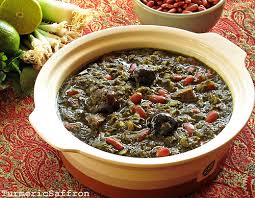 Gormeh Sabzi (Green Herb Stew)
Gormeh Sabzi (Green Herb Stew)
Made from herbs, kidney beans and lamb, deep green gormeh sabzi satisfies two Persian flavor obsessions: it’s sour and full of herbs. The stew is seasoned with dried limes, limoo omani in Farsi. These limes are extra intense and sour, with a bittersweet taste that gives the stew a unique flavor. The other constant in gormeh sabzi is fenugreek leaves, a taste unfamiliar to most westerners. Other herbs include parsley, coriander and scallions.
 Ash e Reshteh (Noodle and Bean Soup)
Ash e Reshteh (Noodle and Bean Soup)
A richly textured soup full of noodles, beans, herbs and leafy greens like spinach and beet leaves. It’s topped with mint oil, crunchy fried onions and sour kashk, a fermented whey product eaten in the Middle East that tastes akin to sour yogurt. The noodles, which made their way to Iran from China, are thought to represent the many paths of life, and this soup is traditionally served when someone sets off on a long journey. Because of its auspicious ingredients, it’s also part of the menu for Norooz, the Persian new year, which occurs at the spring equinox in March.
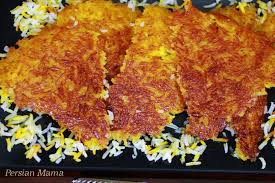 Tahdig (Crunchy Fried Rice)
Tahdig (Crunchy Fried Rice)
Tahdig is the soul food of Persian cooking. It’s the crisp, golden layer of fried rice at the bottom of the rice pot, and it tastes like a combination of popcorn and potato chips, but with the delicate flavor of basmati ice. (Tahdig is usually not printed on the menu, so you may have to ask for it.) At Iranian family gatherings, there are always plenty of leftovers, but the one dish that disappears completely is tahdig. It’s eaten as a side dish, and it’s forgivable to pick it up and eat it with your fingers.
 Jeweled Rice (Rice with Nuts and Dried Fruit)
Jeweled Rice (Rice with Nuts and Dried Fruit)
Dotted with brightly colored dried fruit and nuts, like little jewels, this is a sweet-and-savory dish that shows off some of the native ingredients of Iran, including pistachios, almonds, candied orange peel, barberries, carrots and saffron. It’s cooked with a little sugar to balance the sourness of the barberries. Jeweled rice is served for special occasions, particularly at weddings, because the sweet elements symbolize a sweet life. It’s traditionally served with chicken, which contrasts nicely with the sweetness.
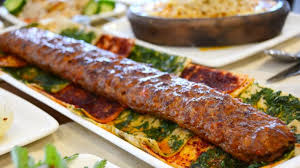 Kebab (Lamb, Chicken, Lamb Liver, Ground Meat)
Kebab (Lamb, Chicken, Lamb Liver, Ground Meat)
Kebabs have more variety than you might think. First, there’s koobideh, ground meat seasoned with minced onion, salt and pepper. It sounds simple, but the taste is sublime. There is kebab-e barg, thinly sliced lamb or beef, flavored with lemon juice and onion and basted with saffron and butter. Chicken kebab, known as joojeh, is traditionally made from a whole chicken, bones and all, for more flavor (although in American restaurants it’s often made from skinless chicken breast), marinated in lemon and onion, and basted with saffron and butter. If you’re lucky, you’ll find jigar, lamb liver kebab, garnished with fresh basil leaves and a wedge of lemon.
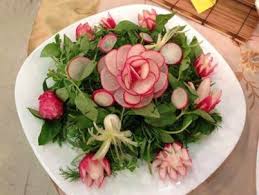 Sabzi Khordan (Herb and Cheese Plate)
Sabzi Khordan (Herb and Cheese Plate)
No Persian meal is complete without a dish of sabzi khordan, or edible herbs. The plate can include mint, tarragon, basil and cilantro, alongside scallions, radishes, walnuts, feta cheese and Iranian nan (flatbread). Simply tear off a piece of flatbread, tuck a bit of the herbs and cheese and other garnishes inside, and fold it up like a rustic sandwich. The plate stays on the table throughout the meal, and the herbs are a crunchy palate cleanser between bites of stew and rice. Fresh and dried green herbs are eaten daily in Iran. The Zoroastrian new year Norooz celebrates rebirth and renewal, and the Norooz menu includes several dishes made with green herbs representing new life, including rice with herbs, an herb omelet and the herb platter.









